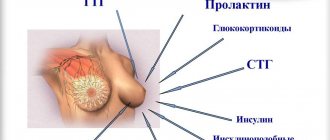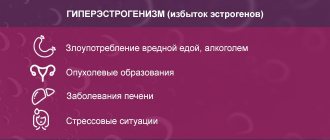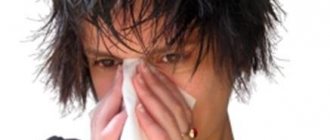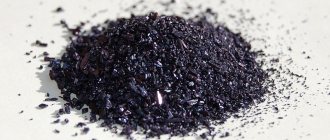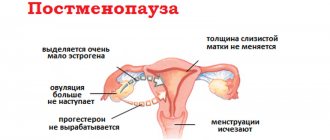The general group of male hormones is commonly called androgens. They are responsible for the formation of male muscles, genitals, hair growth and sexual desire. The main male hormone is testosterone. Moreover, it is present in both male and female bodies. A woman needs such a hormone for the balanced development of the sebaceous glands, bone marrow and other sexual characteristics of the second type. The testes and adrenal glands are the center of androgen development in men, and the ovaries in women. However, the situation gets out of control when an excess of androgen occurs in the female body. Let's look at the reasons for this phenomenon, the symptoms of the disease, diagnostic methods and treatment methods.
Male hormones in the female body - what you need to know?
Hormones are active compounds produced by the adrenal glands, pituitary gland, thyroid gland and reproductive organs.
When enzymes enter the blood, they are responsible for many metabolic processes.
Male hormones are called androgens, and female hormones are called estrogens. Both forms are produced by the endocrine glands.
The main difference between the two types of hormones is different gender. But any organism, both male and female, produces hormones of both types.
What male hormones are present in the female body? The androgenic hormone (testosterone) predominates, but in a girl’s body its concentration should be minimal, only to maintain normal health.
Testosterone in the female body is produced by the ovaries and adrenal glands. When the norm is violated, it immediately affects the girl’s appearance and health.
The role of male hormones in the female body cannot be underestimated, so a lack or excess of testosterone must be treated.
Hirsutism
In case of Achard-Thiers syndrome, it is necessary to determine the level of cortisol, glucose, and body mass index in the blood. In addition, the pituitary gland and adrenal glands are examined (MRI, CT, etc.) to exclude a tumor process. Which doctors should I contact?
Hirsutism therapy is also carried out. But in the process of making a diagnosis, consultation with other specialists may be required, such as a dermatologist (to exclude certain skin diseases), (for complex treatment of patients with manifestations of chronic diseases accompanying hirsutism, correction of their therapy if necessary), a cosmetologist (to select tactics for removing existing hair), surgeon or oncologist (in the presence of tumor processes).
Treatment of hirsutism
Increased hair growth in cases where it is not hereditary hirsutism is a symptom of a more serious disease of the endocrine or reproductive systems; therefore, an important component of therapy is to identify the root cause. When the tumor nature of hirsutism is proven to be localized in the adrenal cortex or pituitary gland, various methods are used to remove or reduce the tumor - surgical treatment, chemotherapy and radiation therapy, etc., which are carried out only by oncologists, chemotherapists, surgeons, neurologists and neurosurgeons with monitoring of organ function and body systems using numerous specialized tests.
Polycystic ovary syndrome requires an integrated approach with the inclusion in the treatment regimen of not only hormonal drugs, but also other medications.
In some cases, surgical removal of the ovary is performed. The choice of therapy is made by the gynecologist.
With correctly selected contraceptives and hormone replacement therapy by a doctor, the unpleasant symptoms of menopause are usually neutralized in menopausal women and the risk of developing hormonal imbalance is minimized.
The selection of medications is carried out by a gynecologist.
Diseases of the thyroid gland with a predominance of hyperfunction require the prescription of drugs that reduce the synthesis of thyroid-stimulating hormones, and can only be prescribed by an endocrinologist after assessing blood test results. Patients with hypothyroidism (reduced thyroid function) are prescribed drugs that replenish the level of thyroid hormones.
Complications
With hirsutism, menstrual irregularities, pathological uterine bleeding, and anemia may occur. Women experience severe psychological discomfort. But doctors consider infertility to be the most dangerous complication of hirsutism.
Prevention of hirsutism
The main preventive measure is timely consultation with a doctor. At the first signs of hair growth in androgen-dependent areas on the body or face and the addition of menstrual irregularities, you should see a gynecologist. Additional preventive measures include a healthy diet and weight control.
Sources:
- .
- Ilovaiskaya I.A. Hyperandrogenic disorders and diseases of women: differential diagnosis and treatment tactics. Gynecology. Endocrinology. No. 6(150). 2021. pp. 49-55.
IMPORTANT!
The information in this section cannot be used for self-diagnosis and self-treatment. In case of pain or other exacerbation of the disease, diagnostic tests should be prescribed only by the attending physician. To make a diagnosis and properly prescribe treatment, you should contact your doctor.
What role do they play?
Male and female hormones, both types, must be in the correct ratio, only then the egg in the body will mature correctly.
The effect of male hormones on the female body cannot be underestimated, as they affect the following processes:
- bone formation and density;
- development of adipose tissue;
- functioning of the central nervous system;
- muscle formation;
- normalization of the function of the sebaceous glands;
- bone marrow functioning;
- regulation of emotions and psychological state;
- improving the functioning of the digestive tract;
- normalization of kidney function.
It is important that androgen hormones, in particular testosterone, have a major impact on a woman’s libido level and sexual desire. a decrease in their concentration leads to a complete lack of sexual desire. When hormone levels increase, on the contrary, a woman becomes very active and even aggressive.
Causes
An increase in free testosterone occurs due to a number of internal and external factors. Exogenous factors usually affect a woman's hormonal levels through food and the environment. Age-related characteristics, pregnancy and lactation, and chronic diseases of organs or systems are considered endogenous.
If the imbalance of hormones is temporary, then this is unlikely to affect the general state of health, however, if the increased testosterone is systemic in nature, then complications will not be long in coming. The main causes of increased testosterone in women are:
- kidney pathologies (functional disorders of the adrenal cortex);
- long-term drug treatment, inadequate drug therapy;
- oncological processes in the body;
- damage to the ovaries of any origin;
- fibroids or uterine polyposis;
- hyper- or hypothyroidism and disruption of the endocrine system;
- heredity;
- Cushing's syndrome, Conn's (with excessive concentration of glucocorticoids);
- alcoholism, drug addiction.
A history of diabetes mellitus and rare genetic diseases are also indirect causes of hyperandrogenism. If the imbalance of the hormone volume is stable for more than a year, then the first symptomatic manifestations appear.
Useful: Cough after eating: cause and how to treat
What male hormones are produced in a woman’s body?
What male hormones are present in the female body?
Experts distinguish six types, but only changes in testosterone levels have the strongest impact on health.
Androgens include:
- dihydrosterone;
- androstenedio or andro;
- dehydroepiandrosterone;
- androsterone;
- androstenediol.
When is elevated testosterone normal in women?
In several cases, elevated testosterone is normal, which is determined by natural changes in the body. There are two main reasons for the norm:
- pregnancy in any trimester;
- puberty.
In the first case, the body is at the peak of its possible load, all resources are used to bear a healthy, full-fledged child. Gynecologists do not even test for elevated testosterone in pregnant women. However, if there was a difficult birth, deviations in the child’s development, or a significant change in figure, then after delivery you should be tested for testosterone levels.
In the second case, when the girl becomes a woman physically and mentally, testosterone is also increased. In girls with increased testosterone, aggressive behavior is increased, there is a tendency towards suicide, oily skin with traces of acne, pimples, and secondary sexual characteristics quickly appear.
Puberty is a difficult period in the life of any teenager. Parents should pay special attention to any changes in the child’s behavior and mental state. If unpleasant symptoms persist for a long time, hormonal therapy is acceptable to normalize the ratio of androgens and estrogens.
Useful: Where is the prostate gland in men located?
Testosterone indicators
To determine the level of male hormones in women, diagnostic tests are performed.
Free and total testosterone are usually studied. In the first case, it is not bound to proteins, in the second case, we are talking about a free hormone and bound to proteins.
Since the concentration of the hormone may change throughout the day, it is recommended to repeat the analysis several times. With its help, the doctor can determine whether a woman has infertility, osteoporosis, or cysts in the ovaries.
The standard free testosterone level is 0.26-1.36 ng/ml.
As for the free active compound, much depends on the age of the woman. For example:
- up to 20 years : 0.13-3.09 pg/ml;
- 21-40 years : 0.13-3.09 pg/ml;
- 41-60 years : 0.13-2.6 pg/ml.
The specified standard values may have a slight deviation depending on the conditions and location of the analysis.
Based on the concentration of the hormone, it is possible to determine how the aging process of the body proceeds. In this case, the upper indicator decreases, and the lower one remains at the same level.
Too low testosterone, which is observed on an ongoing basis, leads to the development of many health problems.
Signs of hormonal imbalance
There are signs that may indicate a hormonal imbalance. Symptoms of increased male hormones or their deficiency appear in a woman one at a time or as a whole complex.
It is impossible to independently determine the degree of violation. It is necessary to consult a doctor and get tested for testosterone and estrogens in the following cases:
- acne appeared on the skin of the face and other parts of the body;
- worried about sudden changes in mood, increased irritability;
- disruptions in the monthly cycle, lack of ovulation;
- abnormal growth of hair on the chest, abdomen, face;
- sudden increase in body weight;
- increased sweating;
- absence or significant decrease in sexual desire.
A prolonged increase in testosterone in a young woman leads to problems with conception, so couples who cannot wait for a baby for a long time are recommended to undergo a comprehensive examination. It includes:
- tests for estrogens, androgens;
- ultrasound scanning of the reproductive organs, mammary gland;
- examination of the adrenal glands and pituitary gland.
Low performance
It is difficult to detect low testosterone levels, since the levels decrease gradually.
But thanks to the presence of some signs, you can independently determine the problem:
- muscle weakness;
- thin voice;
- decreased libido;
- hair loss (baldness);
- deterioration of skin condition;
- excess weight.
It is important to understand that one of the key symptoms is a decrease in the strength of bone tissue, but only a doctor can tell about this after an examination. Although in some cases, excessive brittleness of nails can also be a kind of clue.
Forms of hormonal imbalance
The method of its treatment depends on the type of pathology. They vary depending on the cause of excess hormones:
- Adrenal -
appeared as a result of a tumor or hyperplasia of the adrenal glands; - Ovarian -
the form is caused by polycystic ovary syndrome; - Pituitary -
excess hormone developed after a disease of the pituitary gland; - Metabolic -
the cause of the pathology is a metabolic disorder in the skin.
The most common form is hyperandrogenism.—
very high levels of testosterone in the body.
How to reduce using natural methods?
Lifestyle adjustments can help lower testosterone levels. The following can normalize hormonal levels:
- physical exercise;
- properly selected diet;
- rejection of bad habits;
- taking vitamins;
- reducing stress levels;
- complete rest.
The most important point of the program is a balanced diet. From the menu you need to remove foods that increase testosterone synthesis and reduce estrogen activity. These include:
- all types of red meat (beef, veal, lamb, pork);
- poultry meat;
- coffee and strong black tea;
- seafood (especially oysters);
- nuts;
- fatty fish;
- vegetable oils;
- all types of cabbage (white cabbage, cauliflower, Peking cabbage, broccoli);
- leaf mustard;
- turnip, radish, radish.
When taking vitamin supplements, you should avoid dietary supplements with high zinc content. This element stimulates testosterone synthesis.
A menu based on:
- whole milk, butter, fatty fermented milk products;
- soy proteins;
- lean sea fish;
- sweet fruits (bananas, peaches, pears, melons);
- dried fruits;
- eggs;
- honey;
- starchy vegetables (beets, carrots, potatoes).
- The daily menu may consist of milk porridge with dried fruits for breakfast, carrot cream soup and stewed fish for lunch.
- For dinner, cottage cheese casserole, omelet with smoked fish, and fruit salad are suitable.
- As a snack you can use tofu, dried fruits, baked apples with honey.
- Instead of coffee, it is better to drink mint tea with regular or soy milk, homemade dried fruit compotes and freshly squeezed fruit juices.
Attention! Foods that increase estrogen levels are quite high in calories and can cause obesity. The right choice of dishes will help you avoid the problem.
You should not get carried away with industrial sweets; it is better to give preference to cereals, fruits, and homemade desserts with a small amount of sugar.
The abundance of carbohydrates must be supplemented with fiber, primarily vegetables. They normalize digestion and prevent extra pounds from accumulating.
Moderate physical activity will help normalize hormonal levels. Eastern breathing practices (qigong) and yoga are especially useful.
Exercise not only reduces testosterone synthesis and stimulates estrogen production, but also relieves stress, calms you down, and has a beneficial effect on the female reproductive system.
An important point of the treatment program is the elimination of bad habits .
Smoking is especially dangerous, causing hormonal imbalance, reducing the synthesis of estrogen and progesterone.
Not only regular cigarettes are prohibited, but also their electronic substitutes and even hookahs.
A good night's rest will help lower testosterone levels.
It is necessary to get enough sleep, avoid stress, and rest as much as possible during the day.
It is recommended to abandon staggered work schedules and night shifts, which negatively affect women’s health.
Traditional methods
Traditional medicine offers many means to normalize hormonal levels.
It is recommended to take herbal decoctions; they have a minimum of contraindications and go well with diet and drug treatment.
Women who have kidney problems or suffer from chronic diseases should consult their doctor first.
Peppermint tea can reduce testosterone synthesis .
A handful of fresh raw materials is brewed with a liter of boiling water and infused in a thermos. You should drink at least 2 glasses a day; you can add a little natural honey or milk for taste.Decoctions of angelica, red clover, and licorice root can stimulate the production of estrogen, which suppresses testosterone 1 tbsp. pour a spoonful of raw material into a glass of water, heat it in a water bath and leave covered for 30 minutes. After straining, the infusion is drunk after meals, a single dose is 0.5 cups.
A collection of knotweed, mint, and plantain will help restore hormonal balance 2 tbsp. spoons of a mixture of herbs, taken in equal proportions, are poured with boiling water (2 cups), heated over low heat for 5-7 minutes, infused and filtered. The decoction is divided into equal portions and drunk throughout the day.
Lavender has good antiandrogynous properties . Traditional healers suggest taking soothing baths with a few drops of essential oil and placing sachets of dried flowers in the bedroom. The plant calms, relieves stress, prevents insomnia and improves the perception of stronger medications.


